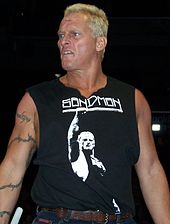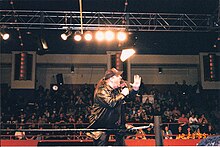Extreme Championship Wrestling
The promotion was known for highlighting a "hardcore wrestling" style, with matches regularly featuring weapons (including the frequent use of tables and fire) and revolving around adult-themed storylines.HHG folded ECW in 2001 when it was unable to secure a new national television contract, and World Wrestling Entertainment, Inc. purchased the assets of the company from bankruptcy in January 2003.It debuted on June 13, 2006, on Sci Fi in the United States and ran for close to four years until it aired its final episode on February 16, 2010, on the rebranded Syfy.Based in the working-class city of Philadelphia, ECW had its origins in 1989 under the banner Tri-State Wrestling Alliance (TWA) owned by Joel Goodhart.[9][10] In 1992, Goodhart sold his share of the company to his partner, Tod Gordon, who created his own promotion from TWA's remnants, Eastern Championship Wrestling (ECW).[11] Heyman's creative influence had an immediate impact on ECW, and throughout 1993 and into 1994 the terms "Hardcore" and "Extreme" were increasingly used to characterize both the in-ring style and the general presentation of the promotion.Instead of relying on former WWF stars such as Jimmy Snuka, Heyman pivoted the promotion to centring around local up-and-coming talents such as Shane Douglas, Sabu, The Sandman and Tommy Dreamer.Additionally, instead of offering cooperation and mutual support, other member promotions of the NWA were undermining ECW's business with underhanded tactics, something Gordon and Heyman wanted revenge for.[16] Gordon made the following announcement on the next edition of ECW programming: I listened with great interest as the representative of the NWA board of directors took it upon himself to inform you that they have the power to force NWA-Eastern Championship Wrestling not to recognize The Franchise, Shane Douglas, as a world heavyweight champion.Seating comprised simple folding chairs and four sets of portable bleachers, with the unconventional scene reflective of the gritty style of the promotion itself.It later moved to a former independent broadcast station (WGTW 48) in Philadelphia on either Friday or Saturday night, and at 1:00 a.m. or at 2:00 a.m. Shows were also aired on the MSG Network in NYC on Friday nights (early Saturday morning) at 2:00 a.m. Due to the obscurity of the stations and ECW itself, as well as the lack of FCC oversight at that late hour, many times expletives and violence were not edited out of these showings, along with extensive use of copyrighted music and music videos.[6] In 1995, Tod Gordon sold Extreme Championship Wrestling, to his head booker, Paul Heyman, trading as HHG Corporation.They advanced a storyline, plugged their first ever pay-per-view and worked three matches in front of the WWF audience while McMahon called the action with both Jerry "The King" Lawler and Paul Heyman.[1][2] Heyman, who became color commentator for Raw is War that February (replacing Jerry Lawler, who quit the WWF in protest after his then-wife, Stacy Carter, had been fired by McMahon), had supposedly never told his wrestlers that ECW was on its last legs and was unable to pay them for a while.Included in that number was $860,000 in accounts receivable owed ECW by In Demand Network (PPV), Acclaim (video games) and Original San Francisco Toy Company (action figures).The highest amounts owed to talents were Rob Van Dam ($150,000),[11][1] Shane Douglas ($145,000),[27] Tommy Dreamer ($100,000),[1] Joey Styles ($50,480),[11][1] Rhyno ($50,000),[11][1] and Francine Fournier ($47,275).[30] In June 2005 an unauthorized DVD called Forever Hardcore was written, directed and produced by Jeremy Borash in response to The Rise and Fall of ECW.[32] Shane McMahon had the idea of an online, low budget show, but they asked television stations and PPV producers and they were interested in ECW.This caused considerable discontent with Heyman, who walked off the project and left WWE entirely in December 2006,[35] beginning a six-year hiatus from professional wrestling.Because of the success of the initial event, three additional shows were held in Autumn 2005 and later the DVD documentary Forever Hardcore was released by the same production crew as a counterpart to WWE's Rise and Fall of ECW.Following Tommy Dreamer's June 2010 debut in Total Nonstop Action Wrestling (TNA), a new stable was formed called EV2.0 consisting of former ECW alumni.As part of the attack, a wooden cross was brought from under the ring and the members of Raven's Nest proceeded to "Crucify" Sandman with it, and enforced the use of religious iconography by placing a "crown" made out of barbed wire on his head in a direct allusion to the Crucifixion of Jesus.Further controversy arose when it came to light that Kulas had lied to ECW owner and booker Paul Heyman about his age and professional wrestling training.In July 2000, ECW made its West Coast debut, holding its annual summer pay-per-view Heat Wave in Los Angeles, California.At the time Los Angeles was home to Xtreme Pro Wrestling (XPW), a recently established promotion which imitated the style and presentation of ECW.[50][51] Prior to the start of the main event, a legitimate out-of-character brawl broke out between the XPW contingent and members of the ECW roster, which spilled out into the parking lot of the venue.










ECW (WWE brand)WWE ECWHardcore wrestlingPhiladelphiaPennsylvaniaScarsdale, New YorkTod GordonPro-Pain Pro WrestlingHardcore HomecomingExtreme RisingHouse of Hardcoreprofessional wrestling promotionNational Wrestling AlliancePaul HeymanEddie GilbertMexicanlucha libreJapanesepuroresuWorld Wrestling FederationWorld Championship WrestlingOne Night Standthird brandSmackDownProfessional wrestlingHistory of professional wrestlingEarly wrestling championshipsGold Dust Trio1980s boomBlack Saturday1994 NWA World Title TournamentMonday Night WarsAttitude Era2000 All Japan Pro Wrestling mass exodusThe InvasionWednesday Night WarsAll Elite WrestlingAll Japan Pro WrestlingAll Japan Women's Pro-WrestlingAll Star WrestlingAmerican Wrestling AssociationConsejo Mundial de Lucha LibreDDT Pro-WrestlingFrontier Martial-Arts WrestlingGorgeous Ladies of WrestlingJim Crockett PromotionsJoint PromotionsLucha Libre AAA WorldwideMajor League WrestlingMaple Leaf WrestlingNew Japan Pro-WrestlingPro Wrestling NoahRing of HonorSoft Ground WrestlingStampede WrestlingTokyo Joshi Pro-WrestlingTotal Nonstop Action WrestlingUWF InternationalWomen of WrestlingWorld Wonder Ring StardomOthersBert AssiratiBilly RileyBilly SandowEd LewisFrank GotchGeorge HackenschmidtThe Great GamaJack PfeferJoe StecherJim LondosLou TheszSalvador LutterothToots MondtBlue DemonBruno SammartinoEl SantoThe Fabulous MoolahGorgeous GeorgeKarl GotchMildred BurkeRikidōzanSam MuchnickStu HartVerne GagneAkira MaedaAndré the GiantAntonio InokiBig DaddyBilly RobinsonBobby HeenanCarlos ColónDusty RhodesDynamite KidGenichiro TenryuGiant BabaGordon SolieHarley RaceHulk HoganJim Crockett Jr.Mil MáscarasNegro NavarroRandy SavageRic FlairSatoru "Tiger Mask" SayamaStan HansenTerry FunkVince McMahonAkira TaueAntonio PeñaAtsushi OnitaBret HartEric BischoffKeiji "The Great Muta" MutoJim RossJushin LigerKenta KobashiKevin NashManami ToyotaMitsuharu MisawaScott HallShawn MichaelsStone Cold Steve AustinTed TurnerThe RockThe Undertaker